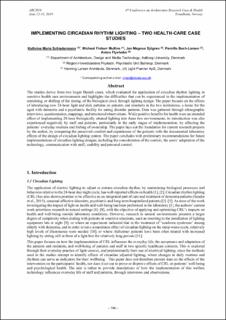| dc.contributor.author | Schledermann, Kathrine Marie | |
| dc.contributor.author | Mullins, Michael Finbarr | |
| dc.contributor.author | Sjögren, Magnus | |
| dc.contributor.author | Bech-Larsen, Pernille | |
| dc.contributor.author | Flyvholm, Anton | |
| dc.date.accessioned | 2022-01-31T18:53:25Z | |
| dc.date.available | 2022-01-31T18:53:25Z | |
| dc.date.issued | 2021 | |
| dc.identifier.isbn | 978-82-536-1718-3 | |
| dc.identifier.issn | 2387-4295 | |
| dc.identifier.uri | https://hdl.handle.net/11250/2976129 | |
| dc.description.abstract | The studies derive from two larger Danish cases, which evaluated the application of circadian rhythm lighting in sensitive health care environments and highlights the difficulties that can be experienced in the implementation of entraining, or shifting of the timing, of the biological clock through lighting design. The paper focuses on the effects of introducing new 24-hour light and dark patterns on patients and residents in the two institutions, a home for the aged with dementia and a psychiatric facility for eating disorder patients. Data was gathered through ethnographic interviews, questionnaires, mappings, and structured observations. While positive benefits for health were an intended effect of implementing 24-hour biologically attuned lighting into these two environments, its introduction was also experienced negatively by staff and patients, particularly in the early stages of implementation, by affecting the patients’ everyday routines and feeling of ownership. The paper lays out the foundation for current research projects by the author, by comparing the perceived comfort and experiences of the patients with the documented laboratory effects of the design of circadian lighting system. The paper concludes with preliminary recommendations for future implementations of circadian lighting designs, including the consideration of the context, the users’ adaptation of the technology, communication with staff, usability and personal control. | |
| dc.language.iso | eng | |
| dc.publisher | SINTEF Academic Press | |
| dc.relation.ispartof | ARCH19 June 12–13, 2019 – Trondheim, Norway. Proceedings from the 4th Conference on Architecture Research Care & Health | |
| dc.relation.ispartofseries | SINTEF Proceedings;8 | |
| dc.rights | CC BY 4.0 | |
| dc.rights.uri | https://creativecommons.org/licenses/by/4.0/ | |
| dc.title | Implementing Circadian Rhythm Lighting – Two Health-Care Case Studies | |
| dc.type | Chapter | |
| dc.type | Peer reviewed | |
| dc.type | Conference object | |
| dc.description.version | publishedVersion | |
| dc.rights.holder | © 2021 The Authors. Published by SINTEF Academic Press. | |

